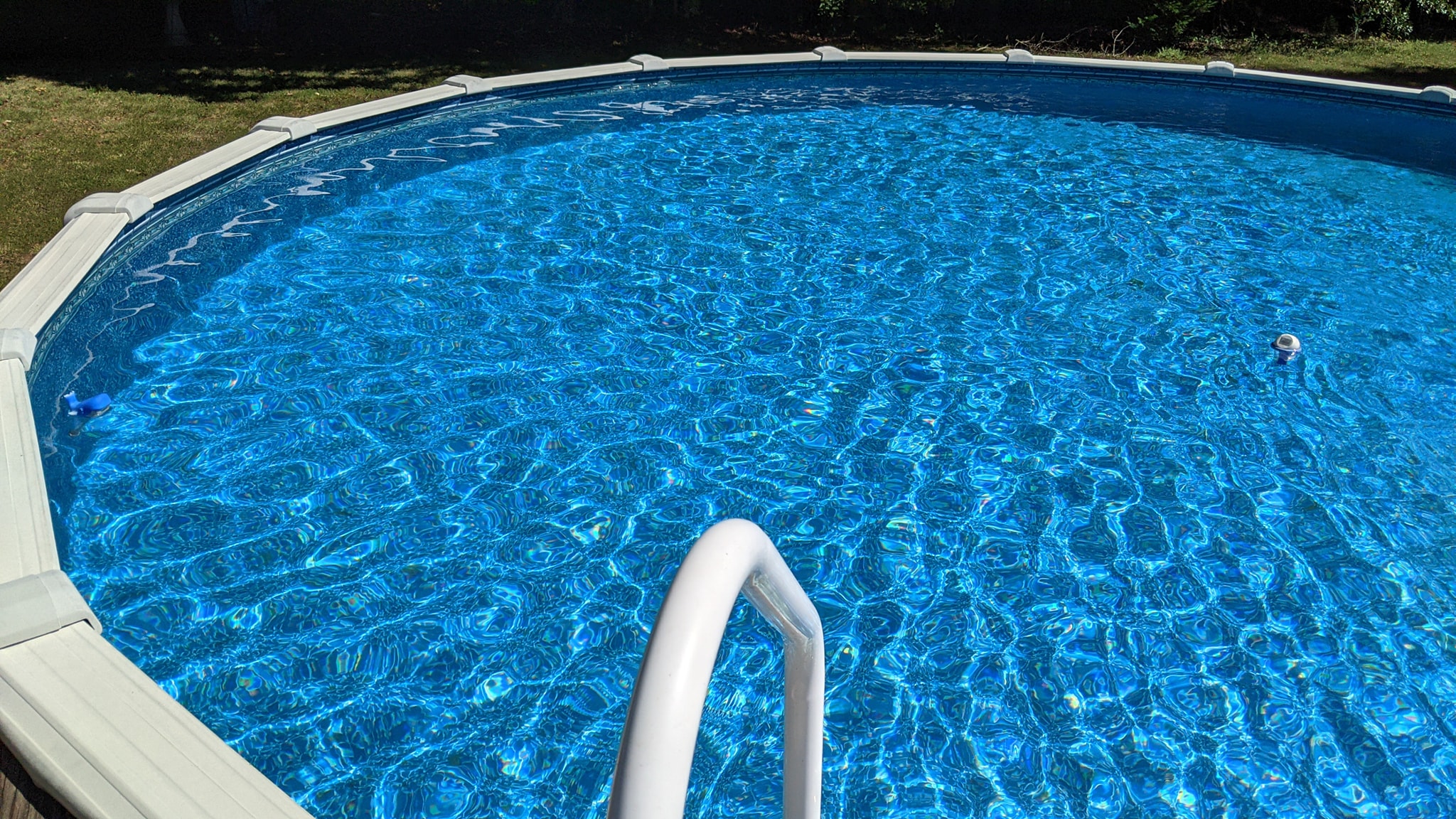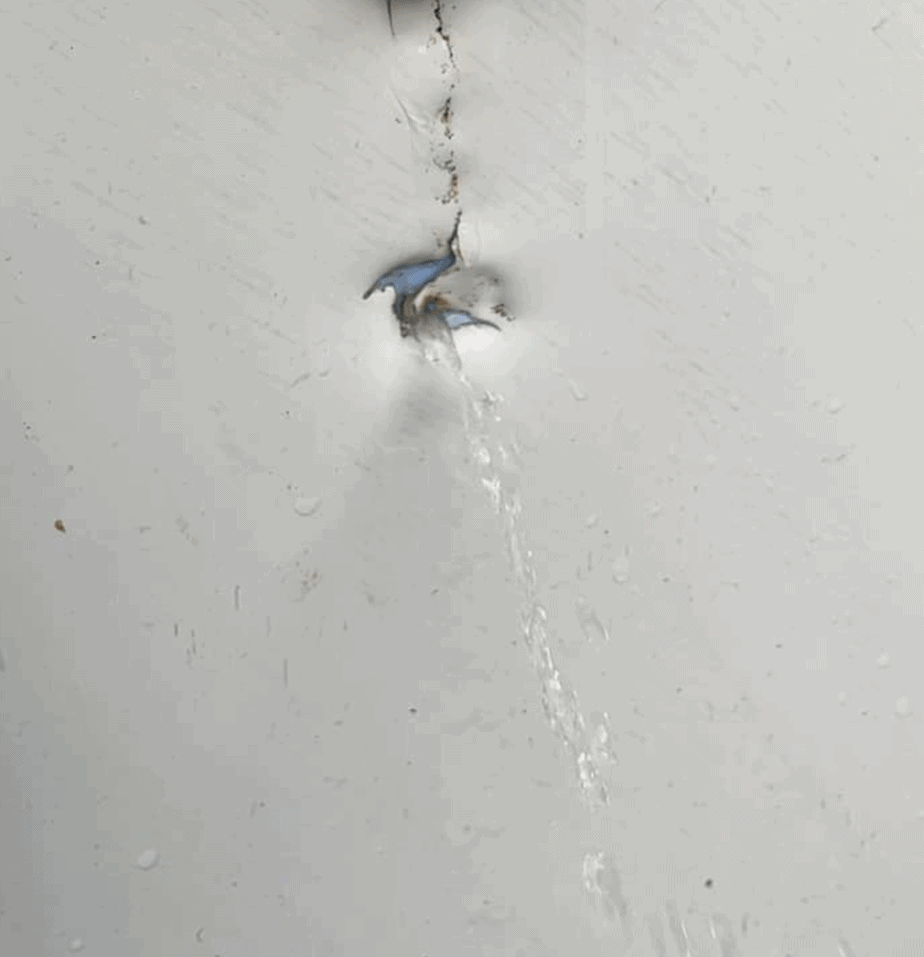Diatomaceous earth or D.E powder should not be added to a sand type filter.

As an administrator of a large Facebook group for above-ground swimming pools, I read a lot of bad advice that pool owners give each other. One is to add D.E. powder to a sand filter.
A sand-type pool filter is designed to filter water by the sand capturing debris as the unfiltered water travels through it. The size of the sand pieces (or aggregate) is large enough to be cleaned by backwashing (reversing the flow of water). Adding D.E. powder will cause the sand to bind together which disallows it to be broken up and cleaned during the backwash cycle.
THE ANATOMY OF A SAND FILTER (FOR ABOVE GROUND POOLS)
To help understand why you should never add D.E. (diatomaceous earth) powder to a sand type filter, here’s a very short description of what is in a sand filter and how it works.
A sand filter has a tank body, top multi-port valve, sand, and a lateral assembly which is attached to a center pipe running inside from top to bottom.
At the bottom of the tank lies what they call a “lateral assembly”. This is just some plastic fingers that have a bunch of slats cut into them and are all connected to a manifold which is connected to the center pipe going upward.
The slats are buried by a bunch of sand, so as the unfiltered water (coming from the pool skimmer) enters the tank, it has to travel through the sand to make it to the laterals (slatted fingers) which are attached to the center pipe, then the water (now considered filtered) goes through the center pipe and back to the pool(by way of the return fitting).
The slats in the lateral assembly are too thin for the filter sand to travel through them, so they can only carry the filtered water back to the pool. These slats ARE big enough to send DE powder back to the pool, but that’s not why I don’t recommend using DE powder.
So, as the unfiltered water goes through the sand, it leaves debris and other small things you don’t want (like some algae) stuck to the sand. The sand then is cleaned when you backwash.
Backwashing is exactly what it says. The water in the tank is reversed (now comes from the bottom and out of the laterals) in the opposite direction through the sand, and is discharged out of the system and into the yard.
THE PROBLEM WITH SAND FILTERS
There are two main issues with sand filters when comparing them to other types. One is that sand filters don’t capture as small of particles from unfiltered water, and the other is that it’s a closed system.
Sand filters are OK, but not great. This is because they cannot clean the water as well as the two other types (cartridge and DE) due to the fact that the sand can’t trap smaller particles.
Sand filters are also considered “closed systems”. This means that it is designed to never be opened. I don’t like closed filtration because you can’t see the actual status of the filter media.
DE filters are considered closed systems too but are designed to be opened periodically for deep cleaning. This is why DE filters are bolted together and can be easily taken completely apart.
Sand filters cannot be easily taken apart. They are a huge pain to open and work on.
Now, because sand filters are closed, you never can tell the status of the sand is inside. This is a problem as the sand can mold together and “cake up” with other debris and you would never know it.
It’s not uncommon for a sand filter to only be filtering with half of its sand and no one notice.
HOW DOES A SAND FILTER “CAKE UP” OR PARTIALLY CLOG?
Sand filters are designed to capture a lot of debris and then the debris gets removed during backwashing and sent out into the yard, thus leaving clean and loose sand. This method works OK but eventually some of the sand will start to cake up.
Sand in the filter starts caking up when it’s not backwashed enough or if a lot of foreign debris was captured in a short period of time. Other sticky things like excessive suntan oils or skin and hair products can aid in the sand caking together. Anything in excess with an ability to get caught in the sand can start to form a solid bond between the aggregate (pieces of sand).
If backwashing doesn’t break up the sand and remove the sticky debris, then it will stay as a caked block and just get worse as new unfiltered water enters the filter body. After a while, this area of the filter will get hard like concrete, and backwashing will never break it up and clean it.
HOW A DE TYPE FILTER WORKS
A D.E. filter has grids inside a tank body that are made of a synthetic material a lot like denim. These grids have a lot of surface area. When the pool pump turns on and initially fills up the filter body, DE (diatomaceous earth) is added through the skimmer. The powder then travels into the filter body and evenly sticks to the grids inside.
This leaves a nice even coat on all of the grids, and since the unfiltered water has to travel through the grids to get back to the pool, the DE coating traps all of the debris.
After a month or so of the DE powder catching all of the debris from unfiltered water, it is backwashed out and into the yard much like a sand filter is. The difference is that new DE powder has to then be introduced through the skimmer to evenly coat the grids once more.
So, DE powder has much smaller particles than filter sand, and therefore cannot be easily cleaned. This is an important distinction when considering putting DE in a sand filter.
D.E. POWDER CAN CAUSE A SAND FILTER TO EASILY “CAKE-UP”
Diatomaceous earth powder is the best filter media for swimming pool water. This is because water can still pass through it even though it’s made up of tiny particles.
This is great as long as the DE powder doesn’t combine with a lot of other bigger aggregates like sand. If it does, it can cake together and make it tough for water to travel through it. And when it does that in a filter body, it stops filtering.
This can happen fairly easily when adding DE to a sand filter. In a short period, the D.E. powder will mix with the sand and start to cake up. And soon after that, the unfiltered water won’t be able to travel through it. The water will simply travel around it and your 150-pound sand filter will now only be filtering with 100 pounds.
The worse part is that since a sand-type filter is a closed system, you won’t know that it is partially clogged. So you’ll be then with a sand filter that is only able to use a portion of the sand in it for filtering.
MY ADVICE ON ENHANCING A SAND FILTER FOR BETTER PERFORMANCE
The reason anyone would consider adding DE powder to a sand filter is to make it better filter. Yeah, don’t do that. And don’t add anything else either. There are no hacks for sand filters.
I know this is the internet. And on the internet, there are shortcuts, cheaper alternatives, and/or hacks for just about everything (including how to add chemicals). And you have to know that most of these great secrets aren’t true and don’t work at all. Adding diatomaceous earth to a sand filter is one of those fallacies.
If you are wanting to make your above-ground pool’s sand filter work better, ask yourself this question – “Why”?
If your sand filter isn’t performing well, then I have the best solution for making it perform better than it ever did before. “Save up and replace it with a good quality cartridge or even a D.E. type filter”. This will be the best thing you ever did to enhance your filter.
Learn more about the three types of filters here.



Thanks for the lesson Dan. You clearly articulated when my common sense gut was saying in my head. Unfortunately your message was buried down a bit below all the “ad DE” messages
Hi. I don’t know what you mean with “add DE” messages. Please explain. If I can improve at making the article clearer, I would like that.
Hey Dan. Thank you for this article. We have a sand filter and I am always wondering how much is in it since some gets washed away with backwashing and is it clean. We usually go by the replacement every 7 years. Currently not having any problems but I came across an article about cleaning the sand with DE. For some reason, my gut was telling me not to do it, but my mind was wanting to very badly so I started reading all these articles which weren’t that many, to be honest, and had my mind made up was going to do it until I read your article. I am not having any issues with it at the moment so why go messing with something that is working fine? I appreciate you taking the time to educate us pool owners who try to become experts in one pool season. What I took away from your advice was NO DE in a sand filter. Couldn’t agree with you more about the dislikes of the closed system.
Thank you. And yes, If everything is working fine, why change it?